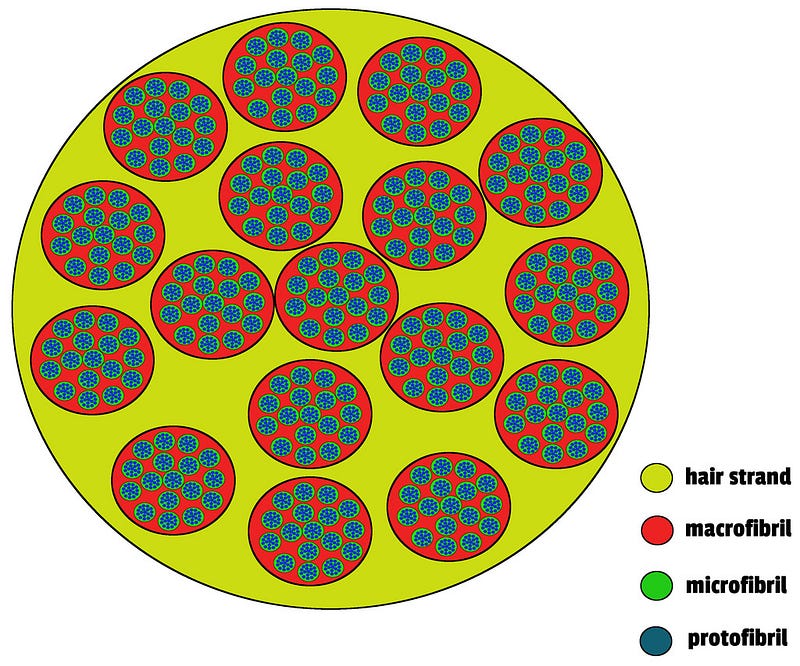Incredible Insights About Hair: Nature's Marvels Unveiled
Written on
Chapter 1: The Wonders of Hair
Hair, something we often overlook, is a remarkable feat of biological engineering. It's capable of being twisted, tied, and styled in countless ways, all while exhibiting impressive strength. Here are some intriguing facts about this often taken-for-granted asset, which we miss when it begins to disappear.
A single hair strand is surprisingly robust, able to support about 3 ounces. With an average of 150,000 hairs on a human head, this amounts to an astonishing capacity to hold around 12 tons—equivalent to the weight of two African elephants.
The impressive strength of hair comes from its structural arrangement. Imagine a suspension bridge supported by multiple cables; similarly, a hair strand is composed of smaller fibers bundled together.
The primary material of hair is a protein known as keratin. If you were to slice a hair strand in half under a microscope, you would find cortical cells arranged in bundles. Delving deeper, you would see keratin macrofibrils within these bundles, which also contain melanin granules responsible for hair color.
Going even further, these macrofibrils consist of smaller components called microfibrils. The microfibrils, in turn, are formed from protofibrils—four keratin strands twisted into a helix. This intricate microscopic structure enables hair to change shape while retaining its form.

The pigmentation of hair is determined by melanin, the same substance that gives color to our skin. While melanin protects the skin from UV radiation by darkening it, hair tends to lighten over time. This occurs because the sun degrades melanin, and unlike living skin, hair cannot regenerate this pigment.
Melanin production for hair color takes place at the hair follicle's base, with two types present: eumelanin, which ranges from brown to black, and pheomelanin, which varies from yellow to red. These pigments collectively define the color of our hair.
As we age, hair often turns gray due to a reduction in pigment production. While the exact reasons behind this phenomenon remain unclear, it is understood that when melanin is absent, hair appears white. The blending of remaining pigment gives it a gray appearance. Notably, the process of hair graying, termed canities, can be influenced by various factors, including stress, although evidence linking stress to accelerated graying is lacking.
On average, a human head sheds about 50 to 100 hairs daily after approximately four years of growth. Men typically start experiencing hair loss around the age of 30. Interestingly, the origins of natural balding, known as androgenic alopecia, were discovered in a rather unusual manner.
Historically, some choir boys were castrated to preserve their high voices, and it was noted that these boys did not lose their hair as they aged. This led to the realization that sex hormones play a significant role in male hair loss.
Balding occurs because testosterone is converted into dihydrotestosterone (DHT) by an enzyme, which contributes to making hair thinner and shorter. The hereditary nature of the enzyme that facilitates this conversion largely influences the degree of hair loss.
Even if a balding man has normal testosterone levels, a higher concentration of this enzyme can lead to more significant hair loss. Interestingly, the enzyme's levels do not increase with age, and it's still uncertain whether it is inherited more from the mother or father. Ultimately, having a genetic predisposition to this enzyme increases the likelihood of experiencing balding.
Additionally, the number of receptors for this enzyme in hair follicles also affects hair loss. Men with more receptors tend to lose hair more rapidly. Asian men generally experience less hair loss, possibly due to having fewer of these receptors or lower enzyme levels. Unfortunately, genetics dictate the hair loss traits one inherits.
Want to explore more captivating facts? Check out Knowledge Stew’s Fact World on Medium.

Chapter 2: Fascinating Hair Insights
This video explores 19 intriguing facts about hair, including its growth and lifespan, demonstrating the complexity of this everyday feature.
In this video, discover 10 captivating facts about human hair, including surprising insights that will leave you amazed!